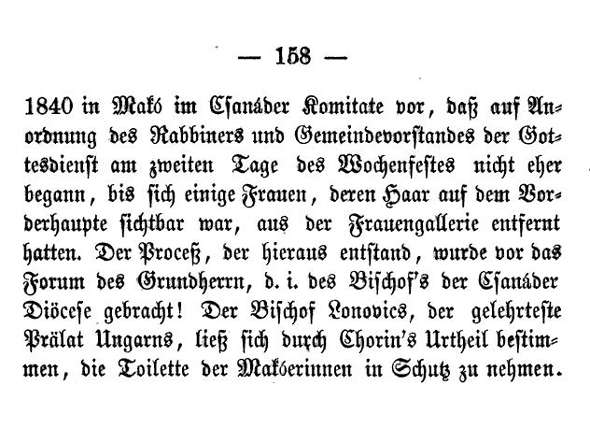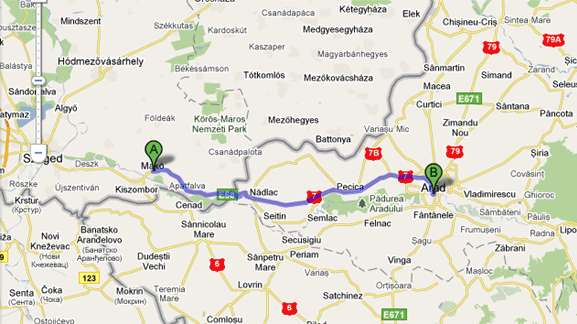This account is from Leopold Low's Der Juedische Congress in Ungarn (1871):

For no other reason that it's cool that you can do this, here is Mako and Arad on the map:

This incident underscores a little-known fact about the rise of Reform Judaism. Only rarely were there communities who were entirely committed to retaining traditional Judaism, or to Reform. More often communities contained both elements, and the direction they went depended obviously on the size and strength of the faction, and which rabbi they were able to appoint. There were places which had a reform-minded rabbi who was unable to implement reforms. There were places with a traditional rabbi who had to fight the reformist element in the community, sometimes more or less successfully. Only in a few places was the sentiment of rabbi and people entirely in harmony, and in those places tradition remained in place, or reforms were instituted. All of this does not even take into consideration the position of the government, which in some places were vehemently against reforms, while in others they were encouraged or required.
Another story:
[My father Louis Ginzberg was fond of telling another story about Dr. [Solomon] Schechter, who was once asked whether sturgeon was kosher. He replied, "Some learned rabbis say that it is; other learned rabbis say that it is not. Who am I to say that the learned rabbis who say that it is kosher are wrong? Louis Ginzberg: Keeper of the Law by Eli Ginzberg pg. 215.Aron Chorin (1766-1844) occupies an interesting and unique place in the history of Reform Judaism. He was a student of the Noda Beyehuda, and was already regarded as a highly suspicious individual before the turn of the century. Not at all that much different from today, somehow controversial positions may be taken by great posekim, but to be a partisan of that position can get you into trouble. The Noda Beyehuda ruled that sturgeon was a kosher fish,[1] but this opinion was not accepted by all other rabbis and became subject of a vigorous debate.[2]
Chorin's first book was printed in 1798. It is a pamphlet called אמרי נועם, the purpose of which was to dispute Rabbi Mordechai Banet's contention that the fish is not kosher. Rabbi Banet himself responded, with words of dismissal seemingly denying that the Noda Beyehuda had permitted it. [3] He says Chorin (albeit not by name; he is called a מורה רוש ולענה) is deserving of niddui excommunication and is just like Yeravam.
These lines in Rabbi Banet's responsum were but a few sentences. But another rabbi took up the lists, writing a pamphlet twice as long as Chorin's, aptly called מקל נועם. This pamphlet argues, among other things, that those original Jews who said that where they are from sturgeon is eaten as a kosher fish were from an Ottoman land where Sabbateanism is rampant. He also employed another . . . questionable technique. The author didn't deny that the Noda Beyehuda had permitted it. He simply said that the Noda Beyehuda changed his mind, and wrote a second responsum to Rabbi Tzvi Hirsch to inform him. However, in fact he sent it to Rabbi Isaac Kriegshaber, the very author of מקל נועם, and he was meant to forward it Rabbi Hirsch. Thus it is irrelevant that the Noda Beyehuda permitted it, since he reversed his position. And the letter is lost, so don't bother looking for it.
If that story smells like old fish to you, it also did to the Noda Beyehuda's son, Rabbi Shmuel Landau. He sent him a rather scathing letter, which he printed alongside his father's original responsum. The letter informs him that in truth Rabbi Shmuel does not want to get involved in a machlokes which has devolved into a fight for victory, not truth. However, since he dragged his father into it he will answer. Rabbi Shmuel writes that he is sending along a copy of his father's responsum permitting. He then asks Rabbi Yitzchak to kindly send him his father's retraction, which he had never heard of. He also asks Rabbi Yitzchak to please give an explanation as to why his father, a prolific letter-writer, would have sent him a letter rather than Rabbi Hirsch, whom he knew well for many years? In truth, Rabbi Shmuel writes, if his father had reversed his decision he would have sent a letter the fastest way possible to prevent people from eating food which isn't kosher. And why is there no copy of the letter among his late father's papers? And if he reversed himself why did he himself allow the original responsum permitting it to be printed without adding that he changed his mind? He basically calls him a liar.
Then the head of the Beis Din of Prague, Rabbi Elazar
Meanwhile, Chorin himself responded מקל נועם to in שרין קשקשים.
Thus, Chorin's first brush with rabbinic controversy. Part II and probably III to come.
[1] See Noda Beyehuda Tinyana YD #28. This responsum was in sent in response to an inquiry from a Rabbi Tzvi Hirsch of Temesvar. The question was, can we really on the testimony of Jews in that place that the aforementioned fish is kosher and eaten in a certain place, and therefore may be eaten? Apparently he sent the fish for Rabbi Landau to examine himself.
In response he points out the usual about the reliability of even one witness in matters of issur, and plays with the complication that in certain instances the similarity of species might render something that is kosher prohibited, etc. Then he notes that he observed scales on the fish. He was able to remove them himself with some kind of instrument, he writes, although they can't be removed by hand in this particular fish that makes no difference. Then he deals with what he refers to as the chumra of the Ramban, that the scales have to be removable in order for a fish to be kosher. Finally, he rules that is is a דג טהור, a kosher fish "without a doubt at all." Not only that, another fish with a similar concern mentioned by the inquirer would also be clearly kosher so long as the situation is the same.
[2] Rabbi Mordechai Banet did not accept this ruling and issued a responsum prohibiting the fish (see הר המור #12). His position is basically that the scales on a sturgeon are so difficult to remove, and there is no normal way of doing it, so it does not meet the requirement of the Ramban. Furthermore, it is the local custom not to accept it as kosher, and even a godol ha-dor can't change that. He closes by humbly acknowledging that he has overstepped his boundaries and is like a pupil who has disputed his master (i.e, the Noda Beyehuda) in order to distance people from sin. But he did so because in his generation truth is diminishing and flattery is increasing. He closes by noting that the debate is not finished., presumably expecting a reply from students of the NBY.
[3] This responsum is in פרשת מרדכי YD #4 .
[4] Rabbi Fleckles printed it in תשובה מאהבה v.3 #329. It is dated 18 Shevat 5521/ February 13, 1800.
Many thanks to Wolf of Ishim ve-Shitos for the reference at the beginning of the post.





Another great post and very timely of course with the Shlomo Miller attacks on Michael Broyde as acher like Aron Choriner.
ReplyDeleteThank you. Can you give us an older psak on Vos Iz Neias ;-)
Excellent post. I knew you wouldn't disappoint.
ReplyDeleteMost if not all of the Orthodox women for whom R. Broyde was trying to find a limmud zekhut would never dream of showing up *in shul* without a hat or at least a doily. If Acher in fact justified such bareheadedness, he was treading where the "MO" would fear to go.
ReplyDeleteS
ReplyDeleteIn view of this Shlomo Miller's comparison to acher looks like a clever historical reference rather than an attack on MO per se. I assume most of the commentators on your previous post were not aware of this.
Midwest
WADR I strongly doubt R"Sh Miller was referring to this minor incident. Rather, he is using Chorin as on epitome of either:
ReplyDelete1. reformer who is a pioneer in destroying Torah
or more likely
2. someone who is destroying Torah by using sourced halachic arguments.
I have my strong doubts Miller knows many details about Chorin.
>In view of this Shlomo Miller's comparison to acher looks like a clever historical reference rather than an attack on MO per se.
ReplyDeleteThis is not widely known. I'm the one being clever.
Most normal people know of Chorin through the polemics against him, particularly references by the Chasam Sofer. A wider circle may have read Eleh Divrei Ha-bris, and it would not surprise me if Rabbi Miller has. Other than that, basically only historians of reform and haskalah (amateur and otherwise) will have read Chorin's own work. In fact many people would probably believe they are ossur to read - and even if not, all you need to know is what the Chasam Sofer says.
Agav, I'd like to thank Wolf of Ishim ve-Shitos, whom I forgot to thank in the post but will remedy, for pointing out this reference to me.